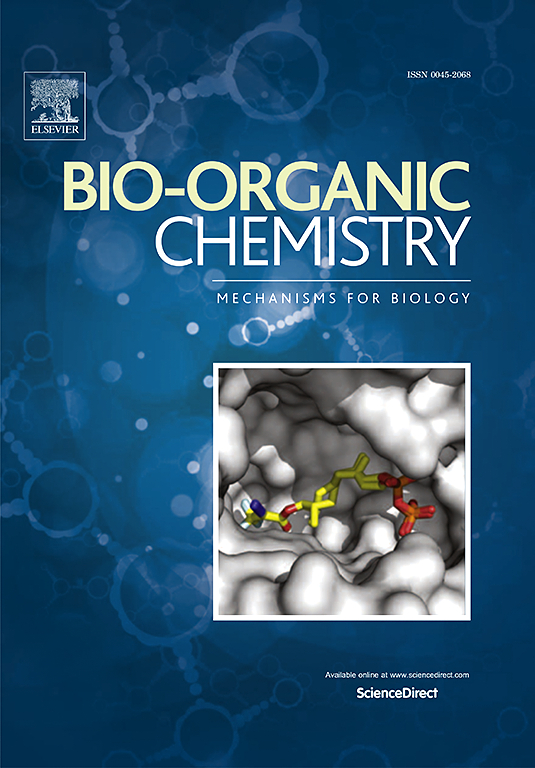白虾衍生的隐肽诱导线粒体介导的人乳腺癌细胞毒性
IF 4.5
2区 医学
Q1 BIOCHEMISTRY & MOLECULAR BIOLOGY
引用次数: 0
摘要
乳腺癌仍然是女性中最常见的癌症。乳腺癌的三阴性亚型与较高的复发率和较差的预后、缺乏有效的靶向治疗选择以及经常对化疗无反应相关。本研究研究了我们先前从南美对虾中发现的硅隐核苷酸对MCF-7、MCF-7- cr和MDA-MB-231癌细胞的体外抗癌潜力。用MTT法检测了5种隐肽ad4、AD7、AD8、AD11和ad12,揭示了对癌细胞的选择性毒性。AD12对MCF-7-CR (~ 4.6 μM)和MDA-MB-231 (~ 20 μM)的IC50计算值最低和最高。机制研究表明,在MCF-7和MDA-MB-231细胞中,由隐肽AD7和AD8介导的细胞毒性诱导了线粒体膜电位的丧失、线粒体细胞色素C的释放和与BAX激活相关的半胱天蛋白酶的裂解。此外,我们的研究结果表明,AD7或AD8处理的MCF-7和MDA-MB-231细胞均出现细胞核凝聚,Caspase 3/7活化,导致凋亡细胞死亡,这与凋亡细胞固有的信号传导机制有关。然而,进一步的研究表明,AD7和AD8肽均促进MCF-7细胞中FAS和p53的上调,而MDA-MB-231细胞中FAS和p53的表达均下调,提示细胞类型依赖性凋亡细胞信号传导机制。此外,AD7和AD8在三维肿瘤模型中均表现出细胞毒性和崩解作用。该研究强调了海洋衍生隐肽对挑战性乳腺癌亚型的抗癌潜力,包括三阴性乳腺癌(TNBC),具有选择性的细胞毒性和克服耐药和复发的潜力。本文章由计算机程序翻译,如有差异,请以英文原文为准。

Whiteleg shrimp-derived Cryptides induce mitochondrial-mediated cytotoxicity in human breast Cancer
Breast cancer remains the most prevalent cancer in females. The triple negative subtype of breast cancer is associated with higher recurrence rates and poorer prognosis, lack of effective targeted therapy options, and frequently becoming unresponsive to chemotherapy. This study investigates the in vitro anti-cancer potential of our previously in silico-discovered cryptides, from Penaeus vannamei, against MCF-7, MCF-7-CR, and MDA-MB-231 cancer cell lines. Five cryptides—AD4, AD7, AD8, AD11, and AD12—were tested using the MTT assay, revealing selective toxicity against cancer cells. The lowest and highest calculated IC50 values were for AD12 against MCF-7-CR (∼4.6 μM) and MDA-MB-231 (∼20 μM), respectively. Mechanistic studies showed that the cytotoxicity mediated by cryptides, AD7 and AD8, induced loss of mitochondrial membrane potential, release of mitochondrial cytochrome C, and cleavage of caspases that were associated with BAX activation in MCF-7 and MDA-MB-231 cells. Furthermore, our results showed that both MCF-7 and MDA-MB-231 cells treated with AD7 or AD8 exhibited nuclei condensation, activation of Caspase 3/7, leading to apoptotic cell death associated with intrinsic apoptotic cell signaling mechanism. However, further investigation showed that both AD7 and AD8 peptides promoted up-regulation of FAS and p53 in MCF-7 cells while down-regulated the expression of both FAS and p53 in MDA-MB-231 cells, suggesting cell-type dependent apoptotic cell signaling mechanisms. Moreover, both AD7 and AD8 demonstrated cytotoxic and disintegration effects in 3D cancer model. This study highlights the anticancer potential of marine-derived cryptides against challenging breast cancer subtypes, including triple-negative breast cancer (TNBC), with selective cytotoxicity and potential to overcome resistance and recurrence.
求助全文
通过发布文献求助,成功后即可免费获取论文全文。
去求助
来源期刊

Bioorganic Chemistry
生物-生化与分子生物学
CiteScore
9.70
自引率
3.90%
发文量
679
审稿时长
31 days
期刊介绍:
Bioorganic Chemistry publishes research that addresses biological questions at the molecular level, using organic chemistry and principles of physical organic chemistry. The scope of the journal covers a range of topics at the organic chemistry-biology interface, including: enzyme catalysis, biotransformation and enzyme inhibition; nucleic acids chemistry; medicinal chemistry; natural product chemistry, natural product synthesis and natural product biosynthesis; antimicrobial agents; lipid and peptide chemistry; biophysical chemistry; biological probes; bio-orthogonal chemistry and biomimetic chemistry.
For manuscripts dealing with synthetic bioactive compounds, the Journal requires that the molecular target of the compounds described must be known, and must be demonstrated experimentally in the manuscript. For studies involving natural products, if the molecular target is unknown, some data beyond simple cell-based toxicity studies to provide insight into the mechanism of action is required. Studies supported by molecular docking are welcome, but must be supported by experimental data. The Journal does not consider manuscripts that are purely theoretical or computational in nature.
The Journal publishes regular articles, short communications and reviews. Reviews are normally invited by Editors or Editorial Board members. Authors of unsolicited reviews should first contact an Editor or Editorial Board member to determine whether the proposed article is within the scope of the Journal.
 求助内容:
求助内容: 应助结果提醒方式:
应助结果提醒方式:


